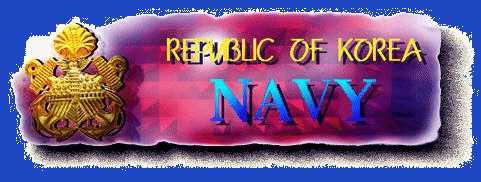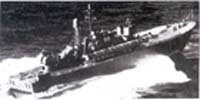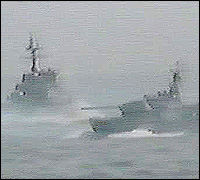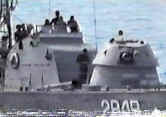
R.O.Korea Navy News
|
South and North Korean warships exchanged gunfire Tuesday in
contested waters of the Yellow Sea only minutes before talks
began to end the standoff, Seoul's Defense Ministry said.
Col. Hwang Dong-kyu, spokesman for the Joint Chiefs of Staff,
said three North Korean ships shot first and their fire was
returned by at least some of the eight South Korean ships
patrolling the area.
``One North Korean ship was hit and is sinking (in the area), but
the other two returned to North Korean waters,'' Hwang said.
One South Korean ship was hit by northern fire, but no casualties
were reported, Hwang said. It was unclear whether there were any
casualties aboard the North Korean ships.
The shooting erupted only 40 minutes before generals of the
American-led U.N. Command and North Korea sat down in the border
village of Panmunjom to discuss the tense military standoff, now
in its eighth day.
North Korea agreed to the meeting after four of its patrol boats
were rammed and briefly repelled by South Korean naval vessels in
the first violent confrontation last Friday.
Two North Korean patrol boats moved back into the disputed waters
shortly after daybreak Tuesday, escorting about 20 fishing boats,
the Defense Ministry said.
They were later joined by three torpedo boats, which the ministry
said began the shooting. It said the exchange of gunfire
continued for about 10 minutes.
North Korean naval patrol boats crossed the maritime
border in the West Sea again yesterday for the seventh
consecutive day, confronting South Korean naval boats for
hours before returning.
The renewed intrusion took place while Pyongyang
accepted an earlier proposal made by South Korea and the
United Nations Command for a general-level officer meeting at
the truce village of Panmunjom to discuss the series of
incursions off the west coast.
The UNC, which oversees a fragile truce between the two
Koreas, said in a statement that North Korea agreed to the
proposed border meeting, which will be convened tomorrow.
"The North's message is viewed as a positive step," the
UNC said, adding, "it remains in everyone's interest to
reduce tension at this time." South Korean military sources
cautiously predicted that it was a sign the Communist North
would cease the maritime incursions.
"But we have no idea what the Communists really have in
mind," a Defense Ministry official said.
North Korea rejected two previous proposals last week.
The latest UNC proposal was delivered to the North Saturday
through Panmunjom.
When the UNC statement was released, four to seven North
Korean patrol boats sailed in and out of the South Korean
waters, escorting fishing boats to a rich crab-fishing zone
near the island of Yonpyong, some 100km northwest of Seoul.
At 6:20 a.m., four North Korean patrol boats began to
violate the sea border, or the Northern Limit Line, and
returned two hours later. At the time Pyongyang was notifying
the UNC it was accepting a proposal for a border meeting.
Then at 11 a.m., seven North Korean naval vessels
intruded the sea border again, travelling up to 5km into the
South Korean waters. They confronted the South Korean Navy
for hours before returning back over the sea border. The
United Nations imposed the NLL, which lies midway between the
North Korean mainland and five South Korean islands, after
the 1950-53 Korean War.
The South Korean Navy dispatched a flotilla of combat
ships to the area, but refrained from opening fire.
An official at the Joint Chiefs of Staff (JCS) in Seoul
said they had detected signs that ground-to-ship missiles
from nearby North Korean shore bases were aimed at the South
Korean patrol boats confronting that had confronted the North
Korean vessel.
A ministry official said South Korean patrol boats were
ready to ram the intruding boats again to push them back to
the North, as they did Friday. Pyongyang threatened to attack
if the South Korean warships didn't withdraw from the area.
South Korean troops were put on heightened alert, and
soldiers' weekend leaves were canceled.
A meeting of top South Korean military leaders who
discussed the confrontation at the Defense Ministry followed
the incursion.
North Korea has contested the sea border since the late
1970s, sending fishing boats and naval ships into the zone 20
to 30 times a year. But when challenged by South Korean
patrol boats, they usually withdrew quickly.
North Korean warships have been sailing in and out of
the area since Monday, escorting a fleet of fishing vessels.
This time, however, they refused to leave for up to 18 hours,
creating a tense standoff with South Korean warships.
Meanwhile, South Korean fishermen in Yonpyong called the
Defense Ministry and claimed that the North Koreans on the
fishing boats were not fishermen, but trained agents and
soldiers, a ministry official said. But he said he could not
confirm the allegations immediately.
After the butting, the North Korean boats, which began
to intrude the sea border Monday, retreated back to north of
the border. The North Korean boats were located some 10 to 11
km south of the border, or the Northern Limit Line - in the
South Korean waters when they ignored repeated warnings and
were hit by South Korean naval ships, the Joint Chiefs of
Staff said.
South Korean naval ships followed the intruders till
they crossed the maritime border back to the North at around
2:15 p.m.
JCS spokesman Col. Hwang Dong-kyu warned that the South
Korean forces "will use more resolute means if they (North
Koreans) violate the NLL again."
He explained that South Korean naval ships "hit the
stern of the intruding boats, pushing them back to the North
without opening fire. We hope it will end the confrontation
and the border violation."
The four North Korean vessel, ranging from 150 to 400
tons, were slightly damaged, and so were some South Korean
naval ships in the bow, said the spokesman.
The hitting took place between 11:40 a.m., some eight
hours after the North Korean boats again crossed the border,
and 12:10 p.m., and about 12 km west of a South Korean island
of Yonpyong, which lies at the center of a rich crab-fishing
zone. The NLL, the maritime extension of the Demilitarized
Zone, was set up at the end of the 1950-53 Korean War.
The South Korean forces' tough action came as North
Korean naval boats ignored repeated warnings from South
Korean Navy and stayed south of the maritime border for 10 to
18 hours a day since Monday.
The action also followed Defense Minister Cho Song-tae's
order Thursday to put all the South Korean troops on
heightened vigilance as the North Korean naval vessel were
continuing violation of the maritime border.
The tough action was hailed by many South Korean
citizens, a Defense Ministry official said.
"The ministry was showered by calls from citizens who
praised our action," he said.
As the North Korean boats' occupation of the fishing
zone continued, the South Korean forces turned from defensive
to aggressive countermeasures Thursday.
After Minister Cho ordered mass deployment of naval
ships, the Navy sent a flotilla of destroyers, frigates,
submarines and other combat ships to the Yonpyong area in a
show of force, while Air Force fighter jets were on the alert
to increase vigilance. Shore guns in the West Sea, attack
helicopters and Special Warfare Command troops were also put
on standby in case of armed provocation by the North.
Earlier yesterday, the Defense Ministry vowed in a
statement that Seoul will "defend the NLL at all cost and
sacrifice," warning North Korea to call back the intruding
naval boats immediately.
"We cannot allow the incursion to continue endlessly and
the violation must stop immediately," the statement said.
It warned that the South Korean forces were ready for
defense against any North Korean possible military action.
But the ministry added it hoped to solve the incursion
in a peaceful manner.
The statement came after Minister Cho presided over an
emergency meeting of top military officials at the Defense
Ministry to discuss countermeasures against the repeated
incursions.
Cho also met Gen. John H. Tilelli, commander in chief of
the United Nations Command, to discuss the confrontation.
On Thursday, South Korea's top security officials met to
discuss the incident and warned that if the intruding boats
didn't return, "we will hold (Pyongyang) responsible for any
consequences that can arise." They labeled the incursion a
"very serious violation by North Korea of the Armistice
Agreement."
On Monday, the six North Korean boats guarding 15 to 30
fishing boats began to cross the NLL into the South Korean
waters. They stayed south of the maritime border for hours
and returned.
South Korea at first tried to tone down the incursion,
describing it as an unintentional, brief border-crossing.
But since Tuesday, they resumed the violation everyday
till yesterday, crossing the NLL early in the morning and
returning late in the evening.
Previously, North Korean naval boats, when crossing the
NLL, returned immediately when South Korean naval ships
warned them to.
In February 1975, a flotilla of North Korean boats
violated the NLL in the West Sea to incapacitate the maritime
border.
But they retreated after a South Korean destroyer hit
their flagship and sank it south of the NLL.
Following repeated intrusions by N. Korean
naval ships
North Korean naval vessels crossed the maritime border
and intruded into the South Korean waters in the West Sea
yesterday for a third time after briefly withdrawing, the
Defense Ministry said.
Six Communist North Korean ships crossed the maritime
border again at around 4:45 a.m., four hours and 30 minutes
after six naval ships withdrew from the prohibited area, the
ministry said.
Amid mounting friction, Defense Minister Cho Sung-tae
called for heightened vigilance among all South Korean troops
as of 2 p.m. yesterday.
A Defense Ministry official warned that South Korea
"will sternly respond" in case of an armed provocation by the
intruding North Korean ships, which stayed a few kilometers
south of the maritime border.
The North Korean flotilla, like on Tuesday and
Wednesday, refused to retreat despite loudspeaker warnings
from South Korean naval ships.
South Korea dispatched eight patrol ships to the area,
some 10 km west of Yonpyong Island and 100km northwest of
Inchon. South Korean naval vessels, like in two previous
incursions, raced around the area in a show of force.
Destroyers and frigates were put 20km to 30km south of the
area.
The North Korean vessels appeared to be protecting about
20 crab-fishing boats.
The official said the North Korean ships really began to
intrude the maritime border Monday afternoon, when they
briefly stayed south of the border called the Northern Limit
Line (NLL).
"At that time, we didn't think it was serious. We
thought the North Koreans would go back and not return," he
said.
North Korean vessels cross the NLL 20 to 30 times a
year, but return shortly after South Korean combat ships
appear, according to the officer.
"But it is the first time that they refused to return to
the North immediately and stayed south of the NLL for several
hours and for three consecutive days," he said.
The NLL, a maritime extension of the Demilitarized Zone,
has served as an effective means of preventing military
tension between South and North Korea for decades and serves
as a practical demarcation line.
The confrontation Wednesday lasted 18 hours, while the
one on Tuesday lasted 11 hours. The last of six North Korean
naval ships that crossed the maritime border on Wednesday
returned to the North at 12:20 a.m. before four appeared
again yesterday morning. During Wednesday's incursion, a
North Korean boat hit a South Korean patrol ship, but no
casualties were reported in the minor clash.
North Korea Wednesday rejected a proposal by South Korea
and the United Nations Command for a Military Armistice
Commission Secretariat meeting at the truce village of
Panmunjom to discuss the series of incursions.
Military sources in Seoul noted that the North Korean
incursion took place when South and North Korean
vice-minister-level officials have agreed to meet on June 21
and when South Korea is providing food and fertilizer aid to
the North, where people are suffering from widespread famine.
They said North Koreans intentionally provoked the
incursion in a bid to nullify the NLL and create some tension
to be used as leverage in the coming talks with South Korea
and the United States.
The Navy launched its eighth domestically produced
submarine yesterday at the Okpo shipyard of Daewoo Heavy
Industries on the southern island of Koje.
The 1,200-ton diesel-powered submarine is equipped with
Harpoon missiles, as well as torpedoes and mines.
The 209-class submarine was christened as "Nadaeyong,"
the 16th-century Naval officer who built the Turtle Ship that
crushed the invading Japanese armada.
The sub has a maximum speed of 22knots (44km per hour),
can conduct independent operations for two months, and is
reinforced with specially-made Korean steel plates.
Daewoo is building the last of nine 209-class submarines
under a Navy program expected to end next year.
The Navy is presently pushing for a new submarine
program to acquire bigger and more powerful submarines.
No casualties were reported in the minor collision and
both sides refrained from gunfire, said the Joint Chiefs of
Staff in Seoul.
Following the collision, the North Korean boats remained
in the buffer zone, a few kilometers south of the sea border
- also known as the "Northern Limit Line" - ignoring repeated
warnings from South Korean boats which were racing around the
area in a show of force.
The South Korean navy barred South Korean fishing boats
from the area and put four combat ships on standby at waters
some 40km south of the buffer zone.
The North Korean boats, which first intruded into the
buffer zone at 1 p.m. and stayed till 11:40 p.m. Tuesday,
ignored South Korean naval patrol boats' warnings, saying
they were protecting North Korean crab-fishing boats, the JCS
said.
The Defense Ministry charged the incursion was an
apparent violation of the 1953 Armistice Agreement, adding
Pyongyang "should take all the responsibility for any results
to be brought by the incursion."
Last year, North Korean naval vessels briefly crossed
the Northern Limit Line about 30 times, but returned
immediately after warnings from South Korean naval boats.
The stand-off began Tuesday after North Korean patrol
boats crossed with several fishing boats into the off-limits
neutral area, which lies in the heart of rich crab-fishing
grounds, some 100km northwest of Inchon.
The six North Korean vessels withdrew late Tuesday, but
returned to the area at around 5:40 a.m. yesterday, escorting
15 crab-fishing boats.
"Instead of using violence, we will continue urging them
to return to the North," a JCS official said.
The buffer zone, one-kilometer wide at its narrowest
point and 15 kilometers at its widest point, was set up below
the maritime border in 1953 at the end of the Korean War.
North Korean vessels stray into the area around 30 times
a year and South Korea traditionally refrains from using
weapons during such incidents. However, the North Koreans
rarely spend prolonged lengths of time in the area.
Eight South Korean patrol boats rushed to the area on
Tuesday to stop the North Korean vessels which were sailing
south in single file.
With his "Sunshine Policy," South Korean President Kim
Dae-jung has been making concerted efforts to bring the rival
Koreas closer together after more than 50 years of
ideological division.
The two sides agreed last week to resume long-stalled
talks, which the South hopes will help open the door to
cooperation and conciliation between the two Koreas.
North Korea watchers in Seoul viewed the incursions as
another example of Pyongyang's double-faced tactic toward
South Korea. The incursion took place after South and North
Korea, in a secret meeting in Beijing last week, agreed to
hold vice-minister-level talks June 21. It also followed
South Korean President Kim's visit to Russia and Mongolia,
where he procured support from the two countries for his
"Sunshine Policy" toward North Korea.
"The hawks in the North, especially the military, always
hates thaws between the two Koreas, and they may need a
certain extent of tension to prove they are necessary," a
Defense Ministry official said.
Some tension is also needed for the North Korean
hierarchy to rule and control their people who are suffering
serious food shortages, he analyzed. He noted that North
Korea received food and other aid from the South and other
countries after it spy submarines and spy boats to the South
last year.
The incursions also followed a North Korean radio
announcement Suwks in the North, especially the military,
always hates thaws between the two Koreas, and they may need
a certain extent of tension to prove they are necessary," a
Defense Ministry official said.
Some tension is also needed for the North Korean
hierarchy to rule and control their people who are suffering
serious food shortages, he analyzed. He noted that North
Korea received food and other aid from the South and other
countries after it spy submarines and spy boats to the South
last year.
The incursions also followed a North Korean radio
announcem
|
 North Korean P-6 torpedo boat hit by
South Korean warship. The 56-ton craft was introduced from the
Soviet Union in 1961, sails at speed of 43 knots per hour.
North Korean P-6 torpedo boat hit by
South Korean warship. The 56-ton craft was introduced from the
Soviet Union in 1961, sails at speed of 43 knots per hour.
 S.K patrol boat(left) chase after N.K boat.
S.K patrol boat(left) chase after N.K boat.
 N.K. boat aim a gun at S.K. boat
N.K. boat aim a gun at S.K. boat
 South Korean naval ships, without opening gunfire, hit
four of six intruding North Korean vessels in the West Sea
yesterday to force them retreat back to the North after the
Communist boats violated the maritime border for fifth
consecutive day, military officials in Seoul said.
South Korean naval ships, without opening gunfire, hit
four of six intruding North Korean vessels in the West Sea
yesterday to force them retreat back to the North after the
Communist boats violated the maritime border for fifth
consecutive day, military officials in Seoul said.